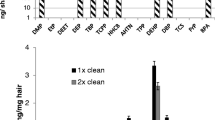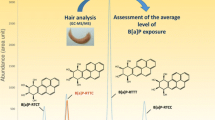Abstract
Objectives
To clarify the origin of dioxin and related compounds (dioxins) in human hair, we determined the amounts of adsorbed dioxins in human hair, and the distribution of 2,3,7,8-tetrachlorodibenzo-p-dioxin (TCDD) in rats.
Methods
Human hair specimens, packed in a glass column, were exposed to ambient air that was introduced into the column with an air pump for 24 h. Rats were administered TCDD by gavage at doses of 0.2, 0.8, and 1.6 μg/kg body weight. Four weeks after TCDD administration, hair from the back, serum, and adipose tissue were removed under diethyl ether anesthesia. The amounts of dioxins in these samples were analyzed by high resolution gas chromatography with mass spectroscopy.
Results
Exposure of the hair specimens to ambient air for one day increased the total toxic equivalent (TEQ) value by 51%. In TCDD-treated rats, the amount of TCDD in hair increased in a dose-dependent manner, and showed a significant positive correlation with that in adipose tissue.
Conclusions
Human hair was found to retain dioxins by both internal and external exposure, and the contribution of external exposure was estimated to be about 40% of the TEQ.
Similar content being viewed by others
References
Nakao T, Aozasa O, Ohta S, Miyata H. Assessment of human exposure to PCDDs, PCDFs and Co-PCBs using hair as a human pollution indicator sample 1: development of analytical method for human hair and evaluation for exposure assessment. Chemosphere. 2002; 48: 885–895.
Miyata H. Dioxin. Chiyoda-ku, Tokyo: Iwanami Shoten; 1999. (Article in Japanese)
Shramm K-W, Kuetter T, Weber S, Lützke K. Dioxin hair analysis as monitoring pool. Chemosphere. 1992; 24: 351–358.
Shramm K-W. Hair: A matrix for non-invasive biominitoring of organic chemicals in mammals. Bull Environ Contam Toxicol. 1997; 59: 396–402.
Covaci A, Tutudaki M, Tsatsakis AM, Schepens P. Hair analysis: another approach for assessment of human exposure to selected persistent organochlorine pollutants. Chemosphere. 2002; 46: 413–418.
Ohgami T, Nonaka S, Maruyama F, et al. A comparative study on polychlorinated biphenyls (PCB) and polychlorinated quaterphenyls (PCQ) in subcutaneous fat tissue, blood and hair of patients with yusho and normal control in Nagasaki Prefecture. Fukuoka Igaku Zasshi. 1989; 80: 307–312.
Ohgami T, Nonaka S, Irifune H, et al. A comparative study on the concentrations of polychlorinated biphenyls (PCBs) and polychlorinated quaterphenyls (PCQs) in the blood and hair of “Yusho” patients and inhabitants of Nagasaki Prefecture. Fukuoka Igaku Zasshi. 1991; 82: 295–299.
Kitamura K, Nagahashi M, Sunaga M, Watanabe S, Nagao M. Balance of intake and excretion of 20 congeners of polychlorinated dibenzo-p-dioxin, polychlorinated dibenzofuran and coplanar polychlorinated bipheniyl in healthy Japanese men. J Health Sci. 2001; 47: 145–154.
Ohsako S, Miyabara Y, Nishimura N, et al. Maternal exposure to a low dose of 2,3,7,8-tetrachlorodibenzo-p-dioxin (TCDD) suppressed the development of reproductive organs of male rats: Dose-dependent increase of mRNA levels of 5-reductase type 2 in contrast to decrease of androgen receptor in the pubertal ventral prostate. Toxicol Sci. 2001; 60: 132–143.
Nishimura N, Miyabara Y, Suzuki JS, et al. Induction of metallothionein in the livers of female Sprague-Dawley rats treated with 2,3,7,8-tetrachlorodibenzo-p-dioxin. Life Science. 2001; 69: 1291–1303.
Popp P, Keil P, Moder M, Paschke A, Thuss U. Application of accelerated solvent extraction followed by gas chromatography, high-performance liquid chromatography and gas chromatography; mass spectrometry for the determination of polycyclic aromatic hydrocarbons, chlorinated pesticides and polychlorinated dibenzo-p-dioxins and dibenzofurans in solid wastes. J Chromatogr. 1997; 774: 203–211.
Hashimoto S, Shibata Y, Tanaka H, Yatsu A, Morita M. PCDDs and PCDFs contamination in the northern pacific area reflected on squid liver tissues. Organchalogen Compounds. 1999; 41: 413–416.
Van den Berg M, Birnbaum L, Bosveld AT, et al. Toxic equivalency factors (TEFs) for PCBs, PCDDs, PCDFs for humans and wildlife. Environ Health Perspect. 1998; 106: 775–792.
Wenning RJ, Paustenbach DJ, Harris MA, Bedbury H, Principal components analysis of potential sources of polychlorinated dibenzo-p-dioxin and dibenzofuran residues in surficial sediments from Newark bay, New Jersey. Arch Environ Contam Toxicol. 1993; 24: 271–289.
Leung HW, Wendling JM, Orth R, Hileman F, Paustenbach DJ. Relative distribution of 2,3,7,8-tetrachlorodibenzo-p-dioxin in human hepatic and adipose tissues. Toxicol Lett. 1990; 50: 275–282.
Van den Molen GW, Kooijiman SA, Slob W. A generic toxicokinetic model for persistent lipophilic compounds in humans: an application to TCDD. Fundam Appl Toxicol. 1996; 31: 83–94.
Choi JW, Miyabara Y, Hashimoto S, Morita M. Comparison of PCDD/F and Coplanar PCB concentrations in Japanese human adipose tissue collected in 1970–1971, 1994–1996 and 2000. Chemosphere. 2002; 47: 591–597.
Ok G, Ji SH, Kim SJ, et al. Monitoring of air pollution by polychlorinated dibenzo-p-dioxins and polychlorinated dibenzofurans of pine needles in Korea. Chemosphere. 2002; 46: 1351–1357.
Hnari N, Horii Y, Okazawa T, et al. Dioxin-like compounds in pine needles around Tokyo Bay, Japan. J Environ Monit. 2004; 6: 305–312.
Nakao T, Aozasa O, Ohta S, Miyata H. Formation of dioxin analogs by open-air incineration of waste wood and fire of buildings and houses concerning Hanshin Great Earthquake in Japan. Chemosphere. 2002; 46: 429–437.
Author information
Authors and Affiliations
Corresponding author
Rights and permissions
About this article
Cite this article
Miyabara, Y., Nishimura, N. & Tohyama, C. Determination of dioxins in human hair: Estimation of external and internal exposure to dioxins. Environ Health Prev Med 10, 86–93 (2005). https://doi.org/10.1007/BF02897998
Received:
Accepted:
Issue Date:
DOI: https://doi.org/10.1007/BF02897998




